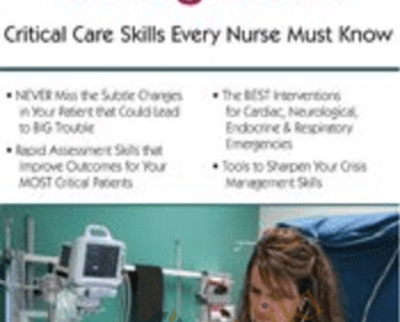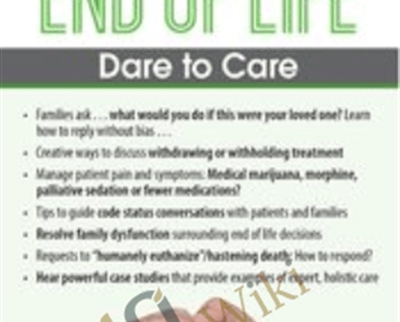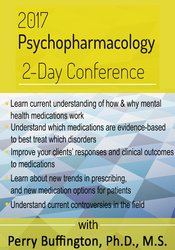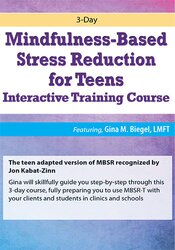Buy Managing Patient Emergencies – Robin Gilbert Course at GBesy. We actively participate in Groupbuys and are committed to sharing knowledge with a wider audience. Rest assured, the quality of our courses matches that of the original sale page. If you prefer, you can also buy directly from the sale page at the full price (the SALEPAGE link is directly provided in the post).
 Mrs. Kelp is admitted with pneumonia and right-sided heart failure. Twenty minutes after admission, she develops worsening dyspnea and hypotension.
Mrs. Kelp is admitted with pneumonia and right-sided heart failure. Twenty minutes after admission, she develops worsening dyspnea and hypotension.
Managing Patient Emergencies by Robin Gilbert,
Salepage link: At HERE. Archive:
- ?NEVER Miss the Subtle Changes in Your Patient that Could Lead to BIG Trouble
- Rapid Assessment Skills that Improve Outcomes for Your MOST Critical Patients
- The BEST Interventions for Cardiac, Neurological, Endocrine & Respiratory Emergencies
- Tools to Sharpen Your Crisis Management Skills
Mrs. Kelp is admitted with pneumonia and right-sided heart failure. Twenty minutes after admission, she develops worsening dyspnea and hypotension.
- Are you prepared to manage her unstable condition?
- Do you know what respiratory measures are necessary?
- Do you know the best way to manage her hypotension?
The patients in our hospitals are sicker than ever before. It is not uncommon to find patients on regular medical floors with central lines, chest tubes, pacemakers and AICDs. Some nursing homes are accepting patients on ventilators, and patients are now being sent home on vasoactive drips such as dobutamine. Even though acuity levels are higher you are still caring for many patients and don’t have the luxury of frequent, comprehensive assessments. Therefore, it is important to be able to rapidly assess and implement appropriate interventions. Attend this seminar to sharpen your skills and leave prepared to identify and manage your next patient emergency!
- Describe two types of rapid assessment techniques and how to employ them for the best results during a patient emergency.
- Evaluate techniques for getting critical information during a rapid patient assessment.
- Investigate EARLY assessment findings in clinical syndromes that may progress rapidly and cause life-threatening conditions.
- Prioritize nursing actions for specific neurological, cardiac, respiratory and endocrine emergencies.
- Review care of the diabetic patient in diabetic ketoacidosis.
- Identify patient populations who are at high-risk for bedside emergencies.
- Discuss how to integrate assessment data and critical lab findings into the plan of care for a patient experiencing a life-threatening emergency.
Identifying the RED Flags
- Critical Thinking During a Crisis
- Vital Signs & ABCDs
- Methods for Establishing and Maintaining Airway
- Breathing: More Than a Rate Issue
- Circulation & Perfusion
- Rapid Assessment Techniques
- Critical Questions to Ask Your Patient
- Identifying High-Risk Populations
- Sick or Not Sick…Who would you see first?
Cardiovascular
Prevention, Presentation, Action for: “I’m having chest pain”
- Recognizing Arrhythmias – Stable, Unstable and Lethal
- Rhythm Recognition & Treatment for: VT, VF, SVT, and Heart Blocks
- Acute Myocardial Infarction: STEMI/NSTEMI
- Key Assessments & Interventions
- tPA Guidelines
- Laboratory Parameters
- Recognizing Subtle Changes
- Hemodynamic Monitoring:
- MAP, CO, SV, CI
- Preload, Afterload, Contractility
- Skills Practice: EKG Interpretation
Respiratory
Prevention, Presentation, Action for: “I can’t breathe”
- Capnography Basics
- Assessment & Critical Interventions for:
- Pulmonary Embolism
- Respiratory Failure
- COPD
- ARDS
- The Patient Who Needs Assistance
- O2, CPAP, BiPAP
- Indications for Intubation
- Positive Pressure Ventilation
- Chest Tube Management
- Easy ABG Analysis…Really!
Endocrine
Prevention, Presentation, Action for: “I don’t feel right”
- The Differences of DKA and HHNK
- Early Recognition of Hypoglycemia
- Critical Lab Findings
- Differentiating the Diagnosis – Case Studies
- Which Intervention Should you do FIRST
- What is the Likely Problem
- Anticipating the Solutions
Neurological
Prevention, Presentation and Action for: “My head hurts!”
- Elevated Intracranial Pressure
- Clues When you Don’t have a Monitor
- Ischemic vs. Hemorrhagic Stroke
- Inclusion/Exclusion for tPA
- Critical Labs
- Malignant Headache
- Delirium
- Autonomic Dysreflexia
- Simulation Lab Review
- Interpreting the Patient’s Presentation
Fluid Imbalance/Circulatory Emergencies
- Sepsis
- Shock
- GI Bleed
- Abdominal Aortic Aneurysm
- Compartment Syndrome
Managing the Decompensating Patient
- No Pulse, No Blood Pressure, No Respirations…Now What?
- Common Medications
- Monitor/Defibrillator Review
- Roles & Responsibilities During a Code
What’s New & Trending
- Ethical Considerations
- Documentation Pitfalls
- Staffing Considerations & High Acuity Patients
Buy the Managing Patient Emergencies – Robin Gilbert course at the best price at GBesy.. After your purchase, you will get access to the downloads page. You can download all the files associated in your order at here and we will also send a download notification email via your mail.
Unlock your full potential with Managing Patient Emergencies – Robin Gilbert courses. our courses are designed to help you excel.
Why wait? Take the first step towards greatness by purchasing Managing Patient Emergencies – Robin Gilbert courses today. We offer a seamless and secure purchasing experience, ensuring your peace of mind. With our trusted payment gateways, Stripe and PayPal, you can confidently complete your transaction knowing that your financial information is protected.
Stripe, known for its robust security measures, provides a safe and reliable payment process. With its encrypted technology, your sensitive data remains confidential throughout the transaction. Rest assured that your purchase is protected.
PayPal, a globally recognized payment platform, offers an additional layer of security. With its buyer protection program, you can feel confident in your purchase. PayPal ensures that your financial details are safeguarded, allowing you to focus on your learning journey.
Is it secure? to Use of?
- Your identity is completely confidential. We do not share your information with anyone. So it is absolutely safe to buy the Managing Patient Emergencies – Robin Gilbert course.
- 100% Safe Checkout Privateness coverage
- Communication and encryption of sensitive knowledge
- All card numbers are encrypted using AES at relaxation-256 and transmitting card numbers runs in a separate internet hosting atmosphere, and doesn’t share or save any data.
How can this course be delivered?
- After your successful payment this “Managing Patient Emergencies – Robin Gilbert course”, Most of the products will come to you immediately. But for some products were posted for offer. Please wait for our response, it might take a few hours due to the time zone difference.
- If this happens, please wait. The technical department will process the link shortly after. You will receive notifications directly by e-mail. We appreciate your wait.
What Shipping Methods Are Available?
- You will receive a download link in the invoice or YOUR ACCOUNT.
- The course link always exists. use your account to login and download the Managing Patient Emergencies – Robin Gilbert course whenever you need.
- You only need to visit a single link, and you can get all the Managing Patient Emergencies – Robin Gilbert course content at once.
- You can do your learning online. You can be downloaded for better results and can study anywhere on any device. Make sure your system does not sleep during the download.
How Do I Track Order?
- We always notice the status of your order immediately after your payment. After 7 days if there is no download link, the system will automatically complete your money.
- We love to hear from you. Please don’t hesitate to email us with any comments, questions and suggestions.
![GBesy [GB] GBesy [GB]](https://www.gbesy.com/wp-content/uploads/2023/05/gbesy-Logo-full-100.png)



 Purchase this course you will earn
Purchase this course you will earn 




Reviews
There are no reviews yet.